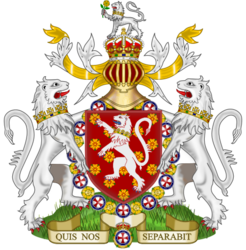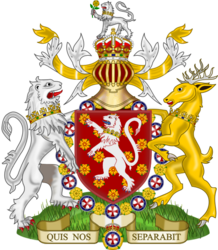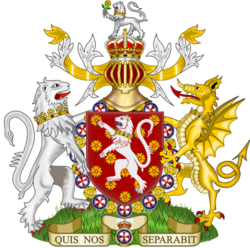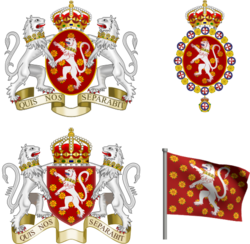Forum:Ingerland/Ingerland coat of arms
We have a flag, but being a heraldry nerd I'm keen for Ingerland to have a coat of arms as well. I have a proposal below and would welcome any feedback, suggestions, or alternative proposals. -- Pawl (talk) 16:55, 5 May 2024 (UTC)
Pawl's proposal
I assume that if it is still a monarchy (and possibly if it isn't) Ingerland should have a coat of arms in the English/West European heraldic tradition. The UK arms quarter those of England, Scotland, and Ireland, but since Ingerland is supposed to be analogous to England only there's no need for quarterings, so I've gone for a single undivided shield.
The shield contains a silver lion (silver is depicted as white in heraldry) on a red field strewn with golden roses (gold is usually depicted as yellow in heraldry). The lion is collared with a royal coronet. I envisage that these arms date back to the early days of heraldry (c.12th century).
The shield is encircled with the collar of Ingerland's senior order of chivalry (The Order of ???), from which hangs the order's badge. The badge contains a red cross patée, as in the flag. On either side are the supporters - two more silver lions.
Above the shield sits a royal helm with gold and ermine mantling, and on the helm is the crest : on the royal crown a silver lion walking ("passant") and holding a golden rose.
I've taken the motto below from the coat of arms of "old Ingerland" - Quis nos separabit - "Who shall separate us". I don't know what its significance is but we can come up with something (or change the motto).
After getting some feedback elsewhere, I've created a variant with a stag as one of the supporters rather than yet another lion, and also one with a gold dragon. The gold dragon could come from the eastern regions, since their neighbour Tircambry uses the gold dragon as a symbol of the nation and its kings.
The silver lion
The lion is extremely common in heraldry, used, among many many other places, in the coats of arms of all seven present-day European kingdoms. It dates from the early days of heraldry, and no doubt was intended to signify power, strength and status (the king of beasts).
The rose
The use of a rose is a nod to the English rose but in a different colour. Having decided to use it I then discovered that a yellow/gold rose also appears below the shield in the coat of arms of Kalm. This could make sense, if the yellow rose is an ancient Kalmish/Gaermanic symbol which they brought with them when they conquered Ingerland. In the real world, there are examples of two countries sharing the same national flower, including two neighbouring countries : Austria and Switzerland both use the edelweiss.
The crown
I have chosen not to use the British royal crown with its alternate crosses patée and fleurs de lys because it is a symbol specifically of the British/Commonwealth crown, as distinctive as any real-world company logo or national flag. For Ingerland I have used only crosses patée on the circlet, which ties in with the cross on the flag. I have also given it four arches instead of two. Four is normal for kings in European heraldry, with two being used by lesser dignitaries such as heirs to the throne. The UK is an oddity in this regard; I don't see why Ingerland should be too!
Other depictions
It is normal in European monarchies for the sovereign and royal court to use the most elaborate, or full, version of the coat of arms and for simpler versions to be used by the state and government. I have included some simpler depictions above, along with the royal standard, which is the shield transposed on to a flag (a heraldic banner).
-- Pawl (talk) 16:55, 5 May 2024 (UTC)
Comments; other ideas?
The designs look very neat and seem both culturally and historically significant! I believe the motto is from the Order of St Patrick (Irish version of the Garter or Thistle). If Ingerland isn’t a union of kingdoms, I wonder whether a reference to “who will separate us” makes sense. This leads me to think that one kind of supporters may be necessary in that case (version 1). Otherwise, nothing to negatively comment :-). I would just suggest making the roses look more metallic-gold on the collar and spreading those on the shield “unevenly” so that they don’t interfere too much with the lion. If you check, for example, the coat of arms of Finland or the Netherlands, you’ll see that background pattern is rearranged so that the foreground elements (paws, tongue) do not overlap.--Aiki (talk) 16:34, 7 May 2024 (UTC)
- Thanks for the feedback Aiki! The motto is Biblical (Romans 8:35), but yes, "Quis separabit" was the motto of the Order of St.Patrick. In our context, it could be religious, or to do with a union of two peoples, some sort of resolved dynastic or communal conflict, or something personal to the person who first used it. I don't have any particular attachment to the motto (it was inherited from the previous coat of arms) and will happily change it if other Ingerlanders want something else.
- Different supporters don't need to represent different kingdoms : 15th and 16th century kings of England used a variety of supporters, sometimes two different ones even though England is a single country. For Ingerland, we could have one represent the eastern regions (UL10-98 & 99) which are more Celtic, but then a dragon might be a better choice (as used by neighbouring Tircambry). I'm still in two minds whether I prefer to have both lions or two different supporters.
- The roses are, in heraldic blazon, semy/semée of roses : in English heraldry, "semy" normally means evenly distributed over the shield and likely to be obscured by charges on top of them (I've seen some renditions of the Dutch arms where some of the billets are partly covered by the lion too). I did try what you suggest but I'm not so keen on it. I might play around with the size of the roses, though.
- I'll have a go at "metalizing" the roses on the collar too - that could be nice! -- Pawl (talk) 08:39, 8 May 2024 (UTC)
- Hi Pawl. You're right, Tudor Kings had different supporters. Another beast such as a Tircambrian dragon (or the unusual weird-looking Antelope the Lancasters used) could be indeed a good idea. Please do not spend unnecessary time on the semé, it was just an idea off the top of my head. Semé means, "heraldicly", charged with unspecified number of smaller pieces from which only a small amount is visible (1899 French heraldry dictionary but you may translate it on line). Your semé is fine as it is.--Aiki (talk) 14:40, 8 May 2024 (UTC)





